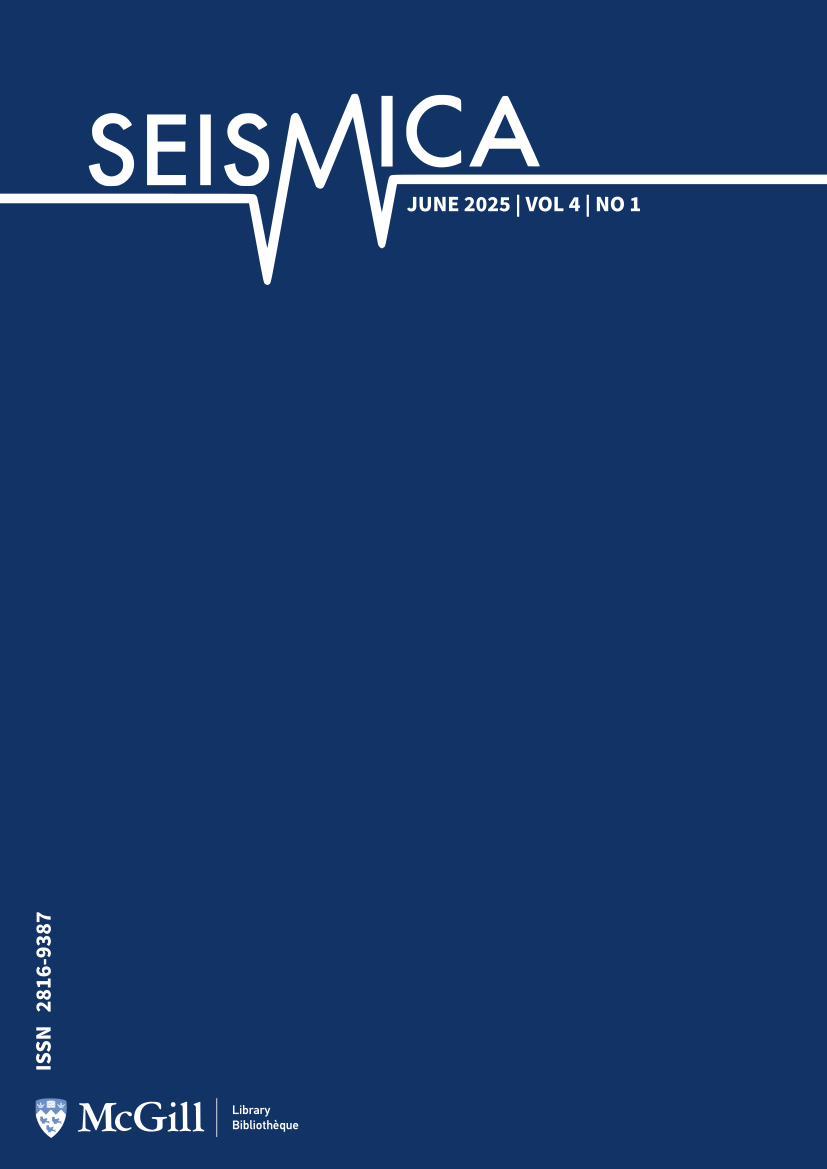Monitoring Time Variations in Seismic Noise Amplitude at Permanent Seismic Networks
DOI:
https://doi.org/10.26443/seismica.v4i1.1408Keywords:
sources of seismic noise, temporal variations, quality checking, permanent networksAbstract
The quality control process usually followed at broad-band seismic networks includes the calculation of the power spectral density and their probability density functions. These results do not make possible a quick estimation of temporal variations that can result from non-continuous sources of noise, meteorologic phenomena, etc. We propose the use of the SeismoRMS package, originally developed to analyze the seismic amplitude variations associated with the COVID19 lockdown, to monitor the time evolution of seismic noise sources in a permanent network, using as a case example the dataset collected during 2023 by the CA network in NE Iberia. Frequencies above 1 Hz show remarkable differences between the stations, despite sharing similar installation settings. Most of the sites show day/night and working day/weekend variations, suggesting a relevant contribution of anthropic sources, but the amplitude of such variations differs strongly among the sites. Our study allows us to identify specific sources of noise affecting some sites during short and regular time periods, an aspect that needs to be taken into account when evaluating the overall quality of each site. We conclude that a systematic analysis of the amplitude variations at different frequency bands can be a tool of interest for the management of a broad-band seismic network.
References
Alexopoulos, J. D., Dilalos, S., Voulgaris, N., Gkosios, V., Giannopoulos, I.-K., Kapetanidis, V., & Kaviris, G. (2023). The Contribution of Near-Surface Geophysics for the Site Characterization of Seismological Stations. Applied Sciences, 13(8), 4932. https://doi.org/10.3390/app13084932
Ashkenazy, Y., & Yizhaq, H. (2023). The diurnal cycle and temporal trends of surface winds. Earth and Planetary Science Letters, 601, 117907. https://doi.org/10.1016/j.epsl.2022.117907
Bromirski, P. D., Duennebier, F. K., & Stephen, R. A. (2005). Mid-ocean microseisms. Geochemistry, Geophysics, Geosystems, 6(4). https://doi.org/10.1029/2004gc000768
Díaz, J. (2016). On the origin of the signals observed across the seismic spectrum. Earth-Science Reviews, 161, 224–232. https://doi.org/10.1016/j.earscirev.2016.07.006
Díaz, J., Ruiz, M., Curto, J. J., Torta, J. M., Ledo, J., Marcuello, A., & Queralt, P. (2020). On the observation of magnetic events on broad-band seismometers. Earth, Planets and Space, 72(1). https://doi.org/10.1186/s40623-020-01236-9
Diaz, J., Ruiz, M., Udina, M., Polls, F., Martí, D., & Bech, J. (2023). Monitoring storm evolution using a high-density seismic network. Scientific Reports, 13(1). https://doi.org/10.1038/s41598-023-28902-8
Díaz, Jordi, Ruiz, M., Sánchez-Pastor, P. S., & Romero, P. (2017). Urban Seismology: on the origin of earth vibrations within a city. Scientific Reports, 7(1). https://doi.org/10.1038/s41598-017-15499-y
Hasselmann, K. (1963). A statistical analysis of the generation of microseisms. Reviews of Geophysics, 1(2), 177–210. https://doi.org/10.1029/rg001i002p00177
Institut Cartogràfic i Geològic de Catalunya. (1984). Catalan Seismic Network [Data set]. International Federation of Digital Seismograph Networks. doi:10.7914/SN/CA
Kozlovskaya, E., & Kozlovsky, A. (2012). Influence of high-latitude geomagnetic pulsations on recordings of broadband force-balanced seismic sensors. Geoscientific Instrumentation, Methods and Data Systems, 1(2), 85–101. https://doi.org/10.5194/gi-1-85-2012
Krischer, L., Megies, T., Barsch, R., Beyreuther, M., Lecocq, T., Caudron, C., & Wassermann, J. (2015). ObsPy: a bridge for seismology into the scientific Python ecosystem. Computational Science & Discovery, 8(1), 14003. https://doi.org/10.1088/1749-4699/8/1/014003
Lecocq, T., Massin, F., Satriano, C., Vanstone, M., & Megies, T. (2020). SeismoRMS - A simple Python/Jupyter Notebook package for studying seismic noise changes, Version 1.0. Zenodo. https://doi.org/10.5281/ZENODO.3820046
Longuet-Higgins, M. S. (1950). A theory of the origin of microseisms. Philosophical Transactions of the Royal Society of London. Series A, Mathematical and Physical Sciences, 243(857), 1–35. https://doi.org/http://dx.doi.org/10.1098/rsta.1950.0012
Nakamura, Y. (1989). A method for dynamic characteristics estimation of subsurface using microtremor on the ground surface. Railway Technical Research Institute, Quarterly Reports, 30(1).
Peterson, J. R. (1993). Observations and modeling of seismic background noise. In Open-File Report. US Geological Survey. https://doi.org/10.3133/ofr93322
Rindraharisaona, E. J., Réchou, A., Fontaine, F. R., Barruol, G., Stamenoff, P., Boudevillain, B., Rigaud‐Louise, F., & Delcher, E. (2022). Seismic Signature of Rain and Wind Inferred From Seismic Data. Earth and Space Science, 9(10). https://doi.org/10.1029/2022ea002328
Stephen, R. A., Spiess, F. N., Collins, J. A., Hildebrand, J. A., Orcutt, J. A., Peal, K. R., Vernon, F. L., & Wooding, F. B. (2003). Ocean Seismic Network Pilot Experiment. Geochemistry, Geophysics, Geosystems, 4(10). https://doi.org/10.1029/2002gc000485
Welch, P. (1967). The use of fast Fourier transform for the estimation of power spectra: A method based on time averaging over short, modified periodograms. IEEE Transactions on Audio and Electroacoustics, 15(2), 70–73. https://doi.org/10.1109/tau.1967.1161901
Wilgus, J. T., Ringler, A. T., Schmandt, B., Wilson, D. C., & Anthony, R. E. (2024). Background Seismic Noise Levels among the Caribbean Network and the Role of Station Proximity to Coastline. Seismological Research Letters, 95(4), 2141–2152. https://doi.org/10.1785/0220230215
Downloads
Additional Files
Published
How to Cite
Issue
Section
License
Copyright (c) 2024 Jordi Diaz, José-Antonio Jara, Pilar Sánchez-Pastor, Tanit Frontera, Helena Seivane, Samuel Jorde, Thomas Lecocq

This work is licensed under a Creative Commons Attribution 4.0 International License.
Funding data
-
Ministerio de Ciencia e Innovación
Grant numbers EPYSIM PID2022-136981NB-I00



